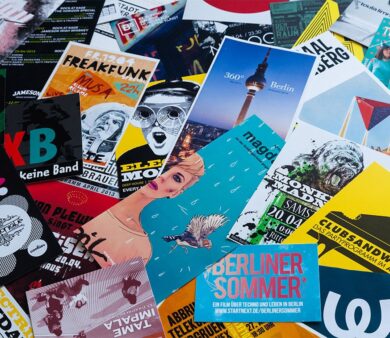Designing your own marketing materials with low-cost graphic design programs
Things have gotten a lot easier for businesses looking to design their own marketing materials. Gone are the days when Adobe’s Photoshop and InDesign were the only real options for creating professional looking promotional materials. A Google search will find plenty of free or low-cost graphic design programs that can help you craft the perfect logo or brochure.
It all sounds easy enough: your marketing budget can’t take the pressure of hiring a graphic designer, so all you have to do is download a program and spend a night putting something together that you can send to your printer tomorrow. But, while the abundance of online resources does make things easier, the process isn’t quite as effortless as you might think.
The fact is, it’s a world of plenty out there when it comes to the do-it-yourself approach to designing marketing materials. The real challenge is finding the right application for your needs. And in many cases, you may need to utilize more than one program. The key is to choose wisely. You don’t want to sink several hours into learning the ins and outs of an application only to discover it doesn’t fully meet your needs.
How do you choose wisely? Doing a bit of prep work prior to diving in will save you time and effort in the long run.
First, develop a set of preliminary questions that provide the groundwork for evaluating the software that’s out there.
What Marketing Materials Will You Create?
Before exploring software options, you need to know what types of promotional materials you want to create. You are building a toolkit of software solutions and no toolbox has just one tool. You will use different solutions depending on your marketing needs.
Most of the material you will be designing will likely require the same program—something that provides you with layout or template options, for example—but others might need you to learn the ropes of a completely different application.
For example, if your first project is to design a logo for your business that you’ll be able to use both online and in your print materials, you may want to use a vector graphics editor like DrawPlus, or you might want to try one of the many online logo creators, such as the free Canva.
Will You Create Your Own Design or Use Something Else?
If you’ll need to create your own images to use in your marketing materials, you’ll have to add more tools to your graphic design toolkit. For example, if you’ll be creating your own images rather than relying on stock photos, you may want to check out image creating programs like Inkscape, a vector graphics creator and editor that’s a free alternative to Adobe Illustrator. And if you already have images that need to be edited, Pixlr is an image and photo editor that comes in both Web-based and desktop versions.
Other applications which might find their way into your toolkit? If you’ll be working with images, you’ll probably put a color tool like Adobe Color CC to good use occasionally. And maybe you’re planning on adding an interactive element to your print materials by using Quick Response (QR) codes. In that case, a QR code generator such as Kaywa QR Code or GOQR.me will come in handy.
Where Will You Work?
This question may seem a bit strange until you consider the range of devices available to most of us these days. Chances are, you’ll be working on your desktop or your laptop, but if you’re an aficionado of the iPad Pro, for example, or like to take advantage of the mobility offered by your smartphone, you might prefer to have a selection of mobile apps at hand as well, preferably ones which sync to the cloud so you can continue working when you get back to the office.
For example, the app Word Swag, available for both iOS and Android, lets you transform your images by adding text to them. While it’s a tool you’d use predominantly for creating images for social media sharing, it may also come in handy when you’re in need of graphics for print promotional materials. Or if you’d like to be able to do some photo and image editing while you’re out and about, Pixlr, mentioned above, also offers Android and iOS versions.
Even if you plan to work entirely on your desktop computer or your laptop, unless you’re opting for a web-based application, you’ll also have to take into account your platform. While many programs are cross-platform, you’ll also find an assortment of programs which are only available for one platform. So the fact that you’ll be working on a Mac or Windows computer may make a difference in the options available to you. For example, the free image and photo editing program Paint.net is available only for Windows, while the relatively low-cost image editor Pixelmator is available only for Mac.
Web-based vs. Desktop: What’s Your Preference?
Graphic design programs come in two flavors today: web-based and desktop. In the first category are applications you access from within your browser. One key advantage of using web-based applications? You’re not platform dependent, so if you have a Mac at work but use a Windows computer at home, you can easily go back and forth between the two environments. And whether you save your work to the cloud, or to a portable storage device, using an online program means you don’t have to worry about having specific software installed on all the computers and laptops you are using.
In addition to Pixlr, Canva and PicMonkey are examples of Web-based graphic design programs.
A desktop program, however, often has the advantage of being more fully-featured. While Adobe’s Photoshop and InDesign come to mind, there are other, low-cost or free, alternatives available which offer an in-depth set of features. The open source, cross-platform program Gimp, for example, is a great free alternative to Photoshop that provides the user with much the same feature set as Photoshop; it comes with a large library of plugins as well, so you can pretty much create any type of effect you desire.
How to Choose Graphic Design Programs
Once you’ve gone over these preliminary questions, you’ll have a better idea of the type of program that will be the most appropriate for your particular purposes. When you dive into your Google search results, though, you’ll find yourself faced with quite a few applications that might be suitable. Evaluate the potential ones by considering the following factors, and you should be well on your way to choosing the best programs for your needs.
Ease of Use
Let’s face it: you’re tackling the design of your own promotional materials because your marketing budget just can’t be squeezed any further to hire a professional designer. But you also need to factor your time into the equation. The cost-saving advantages of doing it yourself may be greatly reduced if you find yourself spending more time than you anticipated to come up with a professional looking result.
A program that has the ability to handle everything you throw at it, such as the full featured Gimp mentioned above, will likely also present you with a steep learning curve. An application like Canva, on the other hand, while not offering you quite as many features, has been designed to be extremely easy to use.
Availability of Tutorials
Even with an easy-to-use application, you may occasionally need to learn how to do something in order to achieve a certain effect or result. A graphic design program with a number of tutorials available will prove helpful if you do run into a design issue down the road. Take some time to see if tutorials are available for the application you’re considering—and make sure to check the quality of the tutorials as well. A tutorial that’s difficult to follow might be even worse than no tutorial at all.
Your Marketing Budget
While a number of good, free graphic design applications exist, many of them also offer a “premium” option. Some programs may also have low-cost templates which can reduce the time you spend on laying out your particular project. If you’d like to work with a template but can’t find a suitable one, you also might be able to purchase one from a designer who’s experienced with working with the particular program you’re contemplating using.
If your marketing budget has enough room for you to take advantage of some of these premium options or to purchase a customizable template, it’s worth the time to check out what you can get for your money. In many cases, you may be able to reduce the time you’ll end up spending on a design project because the program you’re using offers you the elements you need at a price your budget can absorb.
Long Term Support
Good graphic design programs, both free and low-cost, will come and go. The ones mentioned in this article are currently among the most popular, but a few years down the road, some of them might not even be around. It is very unlikely that established, popular software like Photoshop will go belly-up any time soon. If you need ongoing support or just want the security of knowing the application you like will always be around, maybe low-cost or free solutions aren’t a good idea for you.
If you find yourself facing the prospect of creating your own print marketing materials, and your marketing budget is placing restraints on the tools you can utilize, a careful evaluation of your own needs and the features offered by the current free and low-cost tools available online will guide you in choosing the right tool for your specific purposes.



